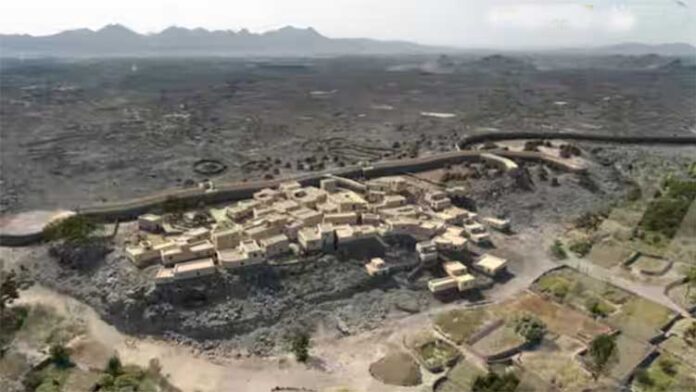In a remarkable archaeological breakthrough, researchers have unearthed a 4,000-year-old Bronze Age settlement on the Arabian Peninsula, believed to have housed nearly 500 residents. This significant discovery provides new insights into the evolution of ancient societies from a nomadic lifestyle to established urban living. The site, named al-Natah, was discovered by French archaeologist Guillaume Charloux alongside a team of Saudi researchers near the Khaybar Oasis.
Al-Natah covers approximately 2.6 hectares (6.4 acres) and is thought to have been constructed around 2400 BCE, remaining inhabited until about 1300 BCE. “Our findings indicate that the people of al-Natah experienced a gradual, region-specific transition toward urbanization,” Charloux stated in an interview with AFP. He highlighted that the town’s structure and surrounding stone barriers suggest a socially organized community, contrasting with the predominantly nomadic tribes that historically occupied the area.
Located close to the city of Al-Ula in the Hejaz region of western Saudi Arabia, al-Natah features a formidable 9-mile-long (14.5-kilometer) wall believed to have provided protection for its inhabitants. The settlement’s layout reflects careful planning, incorporating a central administrative zone, walled gardens, a necropolis, and interconnected residential streets. Archaeologists discovered circular stepped tower tombs and numerous artifacts within the necropolis, including tools, weapons, ornamental rings made of agate, and pottery fragments.
Research conducted in al-Natah and other nearby archaeological sites indicates that the process of urbanization in the Arabian Peninsula was slow. “Settlements in northern Arabia were in a transitional stage of urbanization during the third to second millennium BCE,” researchers noted. This transitional phase has been termed “low urbanization,” as it reflects a period bridging pastoral nomadism and more complex urban settlements.
While urbanization began to flourish in regions such as Mesopotamia and Egypt during the 4th millennium BCE, Charloux’s research suggests that social complexity in northwestern Arabia did not significantly increase until much later. In a related discovery, archaeologists found similar fortifications from the same era at the nearby Tayma Oasis earlier this year, highlighting a broader trend in the region’s archaeological landscape.
One of the lingering mysteries surrounding al-Natah is the reason for its abandonment between 1500 and 1300 BCE. “This is a pertinent question that we cannot answer at the moment,” Charloux remarked, emphasizing the need for further investigation to understand the dynamics that led to the settlement’s decline.
The discovery of al-Natah marks a significant advancement in our understanding of early urbanization in the Arabian Peninsula and offers a glimpse into the lives of its ancient inhabitants. As research continues, archaeologists hope to uncover more about the socio-economic structures and cultural practices of the people who once thrived in this area.
This excavation not only enriches our knowledge of Bronze Age communities but also underscores the historical significance of the Arabian Peninsula as a center of ancient civilization. With ongoing studies and explorations, there remains much to learn about this pivotal period in human history.


